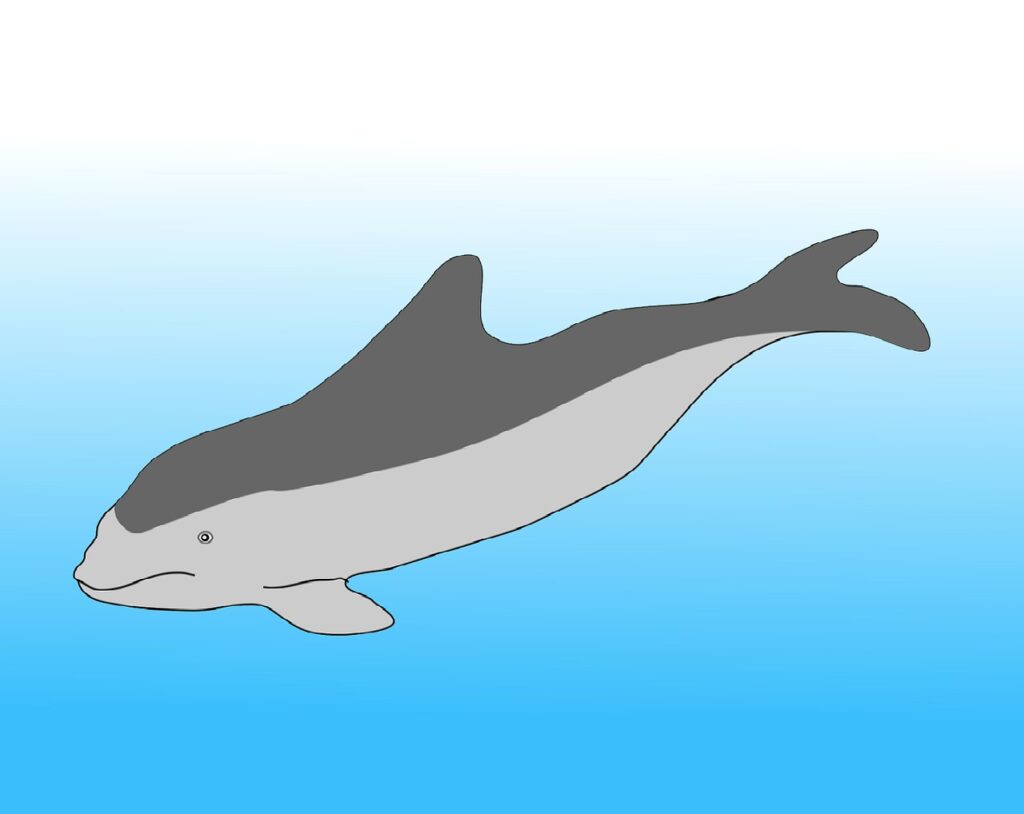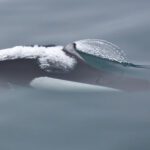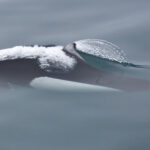This unique marine mammal stands out among its counterparts with its sleek body and black coloring. Found in the coastal waters of South America, it’s often spotted near rocky shores or sandy beaches. It prefers shallow areas and usually travels solo or in small groups of up to 10 individuals.
Burmeister’s Porpoise is well adapted to its environment with its streamlined body allowing for quick movements. It has the amazing ability to emit high-frequency clicks that allow it to locate prey underwater.
Witness the incredible sight of these porpoises jumping out of the water or riding the bow waves created by boats. Don’t miss out on your chance to experience the thrill of seeing them slice through the waves – venture into the world of Burmeister’s Porpoise today!
Key Takeaways
- The Burmeister’s porpoise is a small marine mammal found in the coastal waters of South America, particularly around Argentina and Chile.
- This species is known for its distinctive black and white coloration, with a dark dorsal side and a white belly.
- Burmeister’s porpoises are highly active and agile swimmers, often seen leaping out of the water and riding the bow waves created by boats.
- These porpoises primarily feed on small fish and squid, using echolocation to locate their prey in the water.
- The population of Burmeister’s porpoises is currently stable, but they face threats from fishing activities, pollution, and habitat degradation.
- Conservation efforts are being made to protect these porpoises, including the establishment of marine protected areas and the implementation of fishing regulations.
- Research on the behavior and ecology of Burmeister’s porpoises is ongoing, with scientists studying their movements, feeding habits, and social structure.
- Understanding the biology and conservation needs of this species is crucial for ensuring its long-term survival and maintaining the health of marine ecosystems.
Background information on Burmeister’s Porpoise

Burmeister’s Porpoise is a small marine mammal found in the Southern Hemisphere. It has a robust body and a sleek black color with white markings on its flippers and face. This species feeds on small fish and squid in coastal waters.
They are famous for their playful behavior. You can often see them leaping out of the water or riding boats’ bow waves. They can swim up to 55 km/h! Plus, they have a unique communication system of high-frequency clicks and whistles.
These porpoises were named after German naturalist Hermann Burmeister who first described them in 1865. They are widely distributed along South America’s coasts and their conservation status is stable. However, they are threatened by pollution and accidental entanglement in fishing gear.
Who needs a personal trainer? Just watch a Burmeister’s Porpoise glide through the water and you’ll be motivated to be as graceful!
Physical characteristics of Burmeister’s Porpoise
The Burmeister’s Porpoise is an enigmatic marine mammal. Let’s explore its unique attributes!
Its body is streamlined and dark gray to black on its back and sides, fading to white on its belly. It typically measures 1.8 to 2.2 meters long and weighs 60 to 90 kilograms. It has a prominent triangular dorsal fin towards the rear for stability while swimming, and sharp teeth arranged in a conical shape for grabbing prey. Truly a remarkable creature!
Distribution and habitat of Burmeister’s Porpoise
Burmeister’s Porpoise is a species that inhabits the coastal waters of South America, particularly in the Pacific Ocean. Cool waters and strong currents, like those around the Humboldt Current, are their favorite.
This species can be found off the coasts of Peru, Chile, and Argentina. Here is a table of its distribution and habitat details:

What makes Burmeister’s Porpoise unique is their dislike for shallow waters. Instead, they stay farther offshore in deeper regions.
Hermann Burmeister was the first to describe this creature during his 1835 expedition. Since then, marine biologists and researchers have been intrigued by their distribution patterns and habitat preferences.
It’s like the Burmeister’s Porpoise is an outlaw of the ocean, living life on its own terms with its unpredictable behavior.
Behavior and social structure of Burmeister’s Porpoise
Burmeister’s Porpoise captivates researchers and wildlife enthusiasts alike with their intriguing behavior and complex social structure. They’re characterized by their playful nature and strong social bonds. Showcasing their energetic and curious personalities, they leap out of the water and even ride on boat bow waves.
Their unique communication style combines vocalizations, body movements, and echolocation clicks to convey messages within their groups. This sophisticated form of communication helps them to navigate and locate prey efficiently.
These marine mammals are flexible in their social dynamics, traveling in small pods, large aggregations, or alone when needed. This enables them to adapt to different habitats and increase their chances of survival.
Burmeister’s Porpoises are highly skilled hunters, using echolocation to detect prey accurately. Their meals mainly consist of anchovies, sardines, and squid, which thrive in their coastal habitats.
Unraveling the intricacies of these fascinating creatures’ lives is essential, not only for scientific curiosity, but also for conservation efforts. This knowledge can help ensure the long-term survival of Burmeister’s Porpoises and other vulnerable species sharing the same habitat. Despite this, Burmeister’s Porpoise still faces enough threats to make Aquaman think twice about taking a swim!
Conservation status and threats faced by Burmeister’s Porpoise
Burmeister’s Porpoise needs our help – they face a variety of threats! These include:
- Entanglement in fishing gear
- Habitat degradation from pollution
- Noise disturbance from human activities
Industrial fishing has brought a sharp increase in the accidental capture of these porpoises, causing injury or death. To prevent this “bycatch,” it is important to create more selective fishing techniques.
Pollution is yet another threat. Chemical contaminants and debris pollute their habitats, which can have serious health consequences and disrupt their ecosystem. Waste management and strict regulations on pollutant discharge are key to safeguarding their environment.

Humans also cause underwater noise pollution, which can interfere with the porpoise’s communication and navigation abilities. Reducing vessel speed and implementing noise-reducing measures can help reduce this threat.
Historically, Burmeister’s Porpoise were hunted for their meat and blubber. Though hunting is no longer a major threat, its effects are still present in their population size and distribution.
It is essential to continue conservation initiatives to protect these porpoises from all of these threats. By tackling issues of bycatch, pollution, and noise disturbance, we can help ensure the survival of this remarkable species for future generations to come!
Current research and conservation efforts for Burmeister’s Porpoise
Burmeister’s Porpoise, a highly endangered species of porpoise located in South American waters, has been the focus of major research and conservation efforts. Scientists and environmental groups are researching their behaviors, population dynamics, and environment to come up with efficient strategies to safeguard them.
Currently, researchers are looking into the effect of human activities such as fishing and shipping on Burmeister’s Porpoise. They are analyzing the potential dangers that can arise from these tasks and finding ways to reduce them. By understanding their eating habits and migration patterns, scientists can lessen their contact with commercial fishing gear.
Apart from research, conservation efforts are also being executed to protect Burmeister’s Porpoise. Such initiatives involve government agencies, NGOs, and local communities, and focus on forming protected zones where these porpoises can live. Conservationists are also establishing guidelines and regulations to prevent accidental bycatch in fishing nets and making fishermen aware of the importance of sustaining this severely endangered species.
Pro Tip: Support local conservation organizations striving to save Burmeister’s Porpoise by offering your help or donating to aid their ongoing research and conservation programs. Let’s join forces and make a positive impact on the survival of this unique species.
Frequently Asked Questions
1. What is Burmeister’s Porpoise?
Burmeister’s Porpoise (Phocoena spinipinnis) is a species of porpoise found in the coastal waters of South America. It is named after German naturalist Hermann Burmeister.
2. How big do Burmeister’s Porpoises grow?
Adult Burmeister’s Porpoises can reach a length of about 1.8 to 2.5 meters (6 to 8.2 feet) and weigh around 90 to 110 kilograms (200 to 240 pounds).
3. What do Burmeister’s Porpoises eat?
These porpoises primarily feed on small fish, including anchovies, hake, and sardines. They also consume cephalopods such as squid.
4. Where are Burmeister’s Porpoises found?
They are commonly found along the coasts of Peru, Chile, Argentina, and Uruguay. They inhabit both nearshore and offshore waters.
5. Are Burmeister’s Porpoises endangered?
Burmeister’s Porpoises are currently listed as a species of “Least Concern” on the IUCN Red List. However, their population is threatened by accidental entanglement in fishing nets.
6. Do Burmeister’s Porpoises migrate?
These porpoises are known to undertake seasonal migrations. They move towards colder waters during the summer and return to warmer waters during the winter.
Conclusion
The Burmeister’s porpoise is a captivating sea mammal. It has a sleek body and is known for its playful nature. It is often mistaken for a dolphin, but it has a broader build and lacks the beak which dolphins possess. Its short snout and round head give it an adorable look.
These porpoises are agile in the water. They move swiftly and can evade predators easily. They also show off acrobatic flips and jumps when feeding or socializing.
They mainly inhabit coastal waters in South America, such as Argentina, Chile, Uruguay, and Brazil. They like shallow areas with strong currents, where they can find plenty of fish, squid, and other small creatures to eat.
A remarkable story about a Burmeister’s porpoise happened to some fishermen in Chile. They spotted a porpoise stuck in fishing nets. Quickly, they worked together to free the animal from the mesh without hurting it. When it was freed, the relieved porpoise swam joyfully beside their boat, before diving back into the sea.
References




